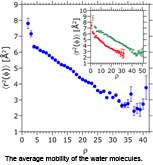Protein surfaces defects act as drug targets

New research shows a physical characterisation of the interface of the body's proteins with water. Identifying the locations where it is easiest to remove water from the interface of target proteins could constitute a novel drug design strategy. The candidate drugs would need to be engineered to bind at the site of the protein where interfacial water is most easily dislodged. These findings, based on the work of María Belén Sierra from the National University of the South, in Bahia Blanca, Argentina and colleagues, were recently published in EPJ E.
The challenge is to describe the protein-water interface without a nanoscale model for water. Previous research tended to regard water as a continuum medium even at interfaces. However, these are inadequate for nanometric scale events occurring on the protein surfaces. Instead, the authors prefer a discrete model describing water molecules' partial confinement on the proteins' surface.
Belén Sierra and colleagues pursued a novel strategy for correlating interfacial water mobility with so-called packing defects in the protein structure. Proteins typically fold in ways that will keep part of their interface with water dry, in order to carry out their biological function. However, some of the paper's authors have previously discovered that the protein's water seal typically has some defects, called dehydrons. These are like crevices on the protein surface permitting access to water molecules.
The water molecules become heated up because they cannot interact with their neighbours as fully as they do in bulk water. These interfacial water molecules are thus unstable and easily expelled. The authors' findings thus pinpoint the exact location of these unstable water molecules. This, in turn, could be useful in selecting future drug candidates that would dislodge these water molecules upon association with the protein on the defect sites.
More information: M. Belén Sierra et al. (2013), Protein packing defects "heat up" interfacial water, European Physical Journal E 36: 62, DOI 10.1140/epje/i2013-13062-7
Journal information: European Physical Journal
Provided by Springer



















